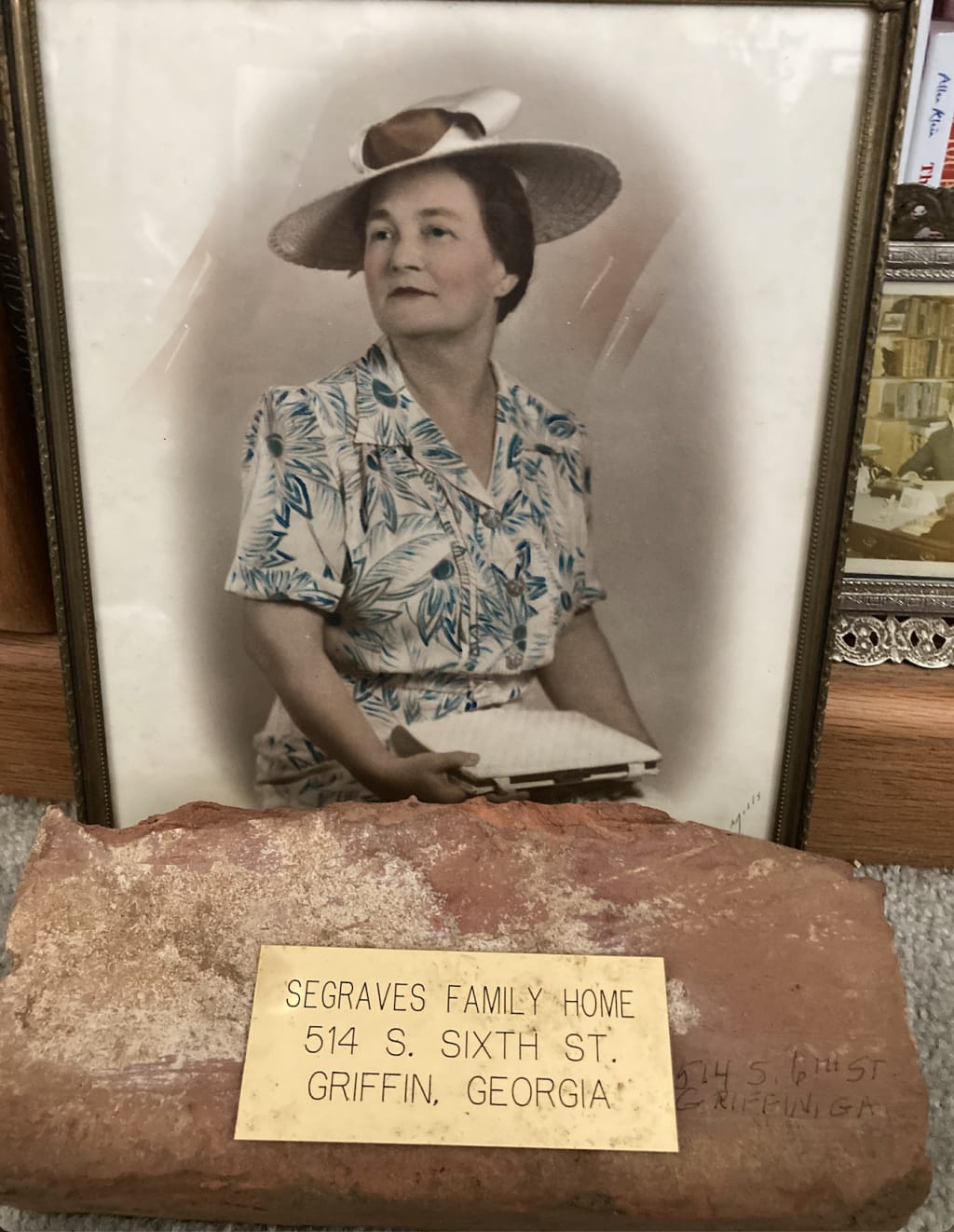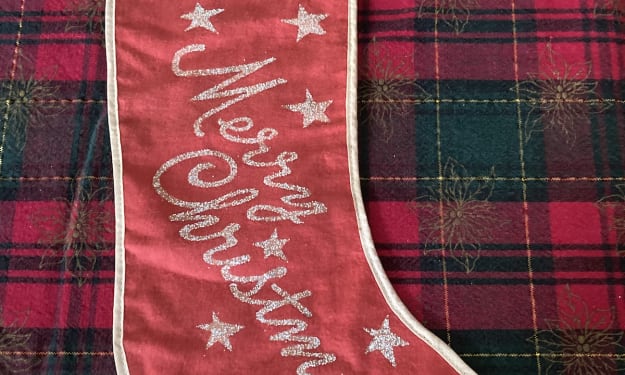514 S. 6th Street, #6
Bricks and Boards

Usually, I don’t keep broken bits and pieces of stuff, but in this case, I made an exception. My mother had a special gift for creating gifts that remind us of something she wanted us to remember. She always let us know why the gift was so important and what it symbolized. I glanced at my shelf and saw the picture of Mamoo, my great grandmother, behind one such gift from my mother. I unknowingly had paired the two, and when glancing over to the shelf, the symbolism of this juxtaposition landed like a ton of bricks on one of the few remaining pieces of 514’s foundation. My mother spent most of her childhood at 514.

I smile when I see the picture we have of our mother as a smiling sweet little girl in her tiny child chair holding a cherished and dirty doll. She is sitting directly in front of the brick foundation. Maybe one of those bricks sits on my shelf today. I'm not sure which part of the foundation my brick supported.
“The only thing holding that house together are the termites holding hands,” my mother would say, and then she’d add, “If they ever let go, that house would collapse.”
Many years ago, when Mom was last at 514, it was being torn down. “The termites finally let go,” she joked. Mom grew up in that house, and its demise brought a bit of closure mixed with memories, regrets, and the nostalgia that both beckoned her home and sent her away with the mantra that her mother drilled into her head, “Get out of Griffin.” She wrote of these in a piece she titled “On the Brink.” It is a haunting account of the love/hate relationship between my mother and the deep-south town she called home.
From the piles of bricks that once served as the foundation, originally stacked a hundred years before, Mom plucked some bricks from the piles, had a little engraved metal plate made and glued onto each one that said, “Segraves Family Home, 514 S. 6th St., Griffin, GA.” She gave one to each of us one Christmas. Mine sits on the shelf in front of the picture of Mamoo, the matriarch of that home until she passed.
The brick returns me to my foundation, begun many generations prior, that stood firm and fragile, just as the roots of most southerners. They lived a rigid faith in Jesus mixed with the pride of those who fought and lost a war in the vain attempt to maintain whatever they thought they had that could only be maintained by the blood and backs of others. My family never had a plantation, although my grandmother lived like Scarlett O’Hara at Tara, and yes, Gone with the Wind was a family favorite. They had a farm with a log cabin home. My family was not rich or poor. They had no debt, owned property, and lived within their means. Nothing was ever wasted. By the time I was born, my family still owned part of the farm and a Civil War chest with a rebel uniform; the supposedly buried silver never resurfaced even though everyone always looked for it. The chest and uniform burned in a fire, but that’s another story. It’s funny that the only part of the chest that survived were the boards at its base, the foundation.
Mom was determined to separate herself from the south and its systems and taught us that some roots were not worth keeping. Those she knew back home used to snicker at her for her for believing all are equal. Just as 514 came tumbling down, so did the old thoughts, ways, and systems tumble out of our lives… or so we’d like to believe. Yet, the reminders are still there, keeping us humble, knowing that our beloved relatives were complicit in oppressing others, and therefore not above anyone else. I love my relatives no matter what, but I do not worship them or their past ways. They lived in times that allowed for an unjust caste system of slavery and society, with many folks holding on to the dead society with pride, and those who may have realized something was wrong still justified the lifestyles with the cliché, “We were not mean to anyone. We were good to our slaves,” never understanding that the foundation of that statement in and of itself creates oppression. When I heard this statement, I always thought to myself, “There are very nice prison guards, but the prisoners are still in prison.”
Mom wanted us to know that the good faith foundation in God needed to remain strong, as well as the love for family, regardless of the problems and promise within each one. Whatever wrong was done, we needed to remember, learn from it, and grow past it. She was bound and determined to keep us from falling into the trap of glorifying Dixie and forced us to let go of the hubris that kept many southerners in a prison based on a crumbling foundation. Just as 514 S. 6th Street came crashing down with its foundation disassembled, the remaining bricks remind us of the love, the faith, the endurance, and the family that moved through conflicts and tribulations into triumphs and eternity.
514 is a place I hold dear in my memories. It’s the past, present, and future, for it is part of our cells, our DNA. It’s long gone, but not forgotten, and its descendants carry on the love, lessons, and perseverance taught from the past. I know and acknowledge our history, repent of the former systems, tear down the walls, disassemble the foundation, cleanse the lands, and then rebuild to help the world heal and become one where all people are created equal. Some of the pieces may be worth salvaging as reminders to reuse or repurpose, yet the others need to be permanently discarded, as were the base boards of the burned civil war chest. However, the lessons remain useful and keep us in check. If I’ve learned anything, it’s to let go of the pride in heritage. Is it fun? Useful? Interesting? Yes, it is, with the caveat that no person or system, living or dead, should ever be idolized, for all fall short of perfection.
Sometimes heritages, always displayed as a dark time, need to remind us of the positive, and we need to look forward to the light and bright spots. These are just as valuable as the lessons. For many people, 514 was a haven. It came to my family after the Civil War, and unlike the family farm, it never owned slaves. In my mother’s writing, she mentions the foster children brought in, opening the door to those needing a roof over their heads and reaching out to the needy. My great-great grandfather purchased the home in town after my great-great grandmother died and left him with seven children so that the family always had a place and could walk to town for whatever was needed. Mamoo rented out the front room, and whenever family or foster needed a place, she opened her doors and welcomed them in. Some stayed well into their senior years.
To me, 514 was where those I loved very much lived. It was where I sat on my great grandmother’s lap as she read to me at night. It was where I stayed when I was quite ill. There was always a dog to pet, fresh peaches in the bowl on the buffet, and someone to hug or listen to my stories. It was a place where I was always welcome, and after I was married, my husband was welcomed there, too. We even had friends that stayed there with us. The door was always opened, and we were always greeted with a smile.

I always bought into the idea having a home that was owned outright and opened for any family member needing a place to stay. My sister lived this when she opened her home to anyone needing a roof over their heads, even to the point where every room was full, and she only had her bedroom as a retreat. Children were everywhere. The living room was covered with mattresses for women needing a safe place to stay. Susan was a lot like Mamoo in so many ways.
Recently, I have heard 514 calling from its grave, reminding me to revisit the good, the bad, and the lessons learned from both. I see the brick, my great grandmother, and my mother as a child. I heard my mother’s voice as I reread “On the Brink,” a piece she wrote a few years before she passed. In it, her writing returns her to 514, beginning with the good and then facing the reality.
“I am a child of the south. No matter where I live, I’m as connected to my roots as an umbilical cord is to a fetus. I twist and turn but it’s always near-by – sometimes almost choking me…
“…What do I feel about my roots? – A deep, desperate love and a heavy, inconsolable, haunting sadness for the things my family endured in making a home for anyone that needed one – relative and non-relative alike…
“’Get out of Griffin,’ my mother said over and over again like a mantra. ‘If you stay here, it will kill you…calling you back in order to suck the life out of you to feed its small-town pettiness and good ole boy largesse.
“So, I got out of Griffin. But I can’t seem to get Griffin out of me.”
In that piece, “Come back to Heaven,” and “Come back to Hell,” call out from the grave, the bricks, and the memories, and my mother responds, “Knowing full well that even as she calls me, she will smack me down if I go back. I wonder if I’ll answer her call.”
But Mom gave us the brick for a reason.
Bricks supported the boards that the termites held together. The foundation, firmly set, supported the fragile people, their beliefs, and their little world. So what do we do with a lone brick? It’s not like I can build anything with it. It’s one brick, one tiny piece of a foundation that supported a house. It is a reminder, and in hindsight, I take what I know and learn to use this as the foundation that makes the world a little better for others. Lessons of love, endurance, perseverance, faith, hospitality, and hope survived long after the house was gone. The “old” ways that embraced a failed society that was supported by the foundation of slavery collapsed along with the house. In the end, the values that make the world a better place survive through generations influenced by those who lived at 514. “Remember,” says the brick, “but do not glorify in the past. Learn from it. Build a better foundation.”
What “bricks” from the past do you have? Do they have a message? What reminders do they share with you?

#livingwithgussto #connectinggenerations #514s6thst #griffinga #bricksandboards
About the Creator
Nancy Nason Guss
Nancy Nason Guss, a retired career educator, is Living with Gussto, a life filled with Books, Bagpipes, & Blogs. In addition to playing bagpipes, she's published pieces for all ages that process life's triumphs and tribulations.






Comments
There are no comments for this story
Be the first to respond and start the conversation.